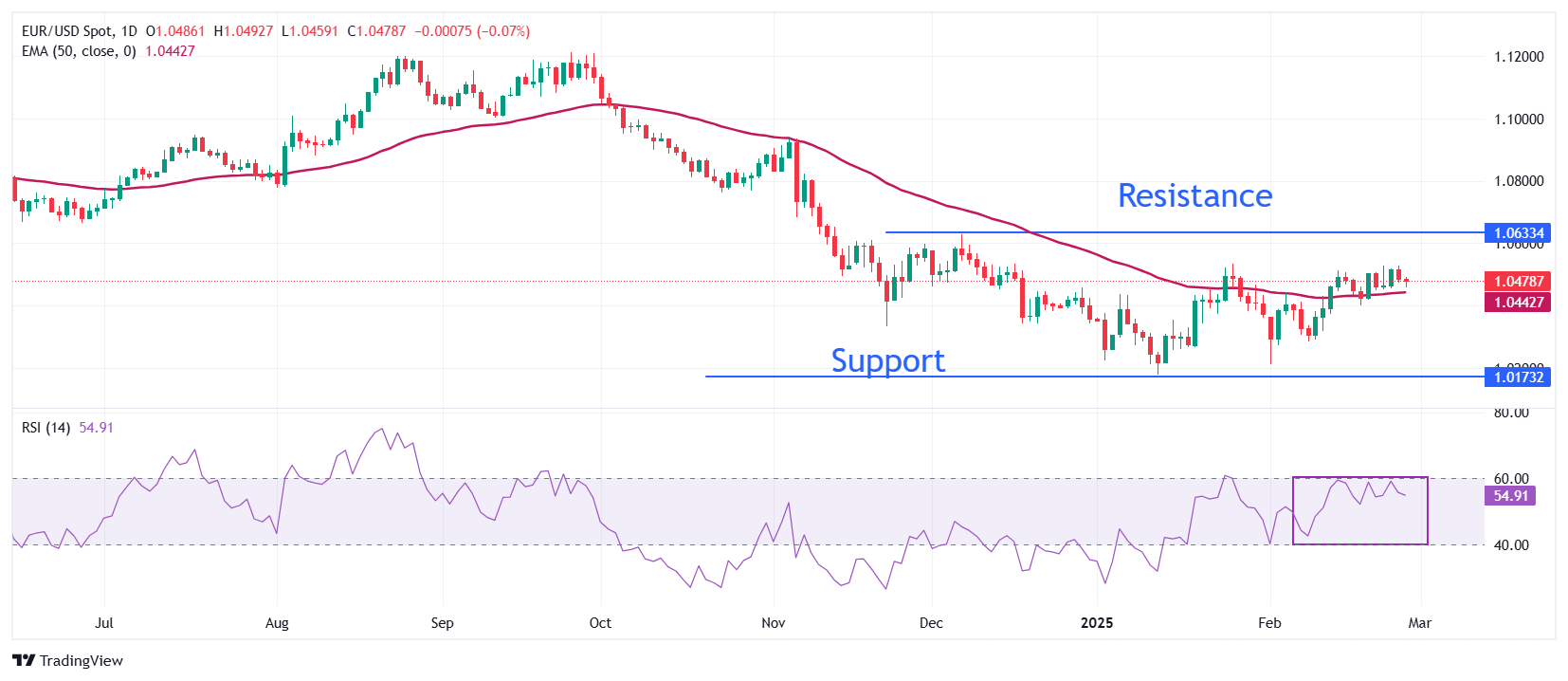提供最佳价差和条件
 关于平台
关于平台
EUR/USD faces pressure below the psychological level of 1.0500 in European trading hours on Thursday. The major currency pair drops as United States (US) President Donald Trump reiterated tariff threats on the Eurozone.
President Trump said in a press conference on Wednesday that he will announce 25% tariffs on “cars and other things” on the Eurozone “very soon.” However, Trump didn’t provide a timeline for the tariff imposition.
In response to Trump’s tariff threats, a European Commission (EC) spokesperson said, "The EU will react firmly and immediately against unjustified barriers to free and fair trade, including when tariffs are used to challenge legal and non-discriminatory policies.”
A tariff war between the US and the Eurozone would make the Eurozone economy vulnerable to growth, which is already fractured due to weak demand. Such a scenario would weigh on the Euro (EUR).
Meanwhile, uncertainty over the outcome of negotiations to form a German coalition government has also kept the Euro (EUR) on the backfoot. Victorious Frederich Merz’s conservative Christian Democratic Union of Germany (CDU) will most likely form the government with outgoing Chancellor Olaf Scholz’s Social Democratic Party of Germany (SPD).
On Wednesday, Bundesbank President Joachim Nagel said in an interview with Reuters on the sidelines of a meeting of G20 finance chiefs that the new German government should address “structural faults” in the economy quickly to improve “Germany’s competitiveness”.

EUR/USD stays in a tight range at around 1.0500 on Thursday as the 50-day Exponential Moving Average (EMA) continues to support the major currency pair around 1.0440.
The 14-day Relative Strength Index (RSI) wobbles below the 60.00 level. A bullish momentum would activate if the RSI (14) manages to sustain above that level.
Looking down, the February 10 low of 1.0285 will act as the major support zone for the pair. Conversely, the December 6 high of 1.0630 will be the key barrier for the Euro bulls.
The Euro is the currency for the 19 European Union countries that belong to the Eurozone. It is the second most heavily traded currency in the world behind the US Dollar. In 2022, it accounted for 31% of all foreign exchange transactions, with an average daily turnover of over $2.2 trillion a day. EUR/USD is the most heavily traded currency pair in the world, accounting for an estimated 30% off all transactions, followed by EUR/JPY (4%), EUR/GBP (3%) and EUR/AUD (2%).
The European Central Bank (ECB) in Frankfurt, Germany, is the reserve bank for the Eurozone. The ECB sets interest rates and manages monetary policy. The ECB’s primary mandate is to maintain price stability, which means either controlling inflation or stimulating growth. Its primary tool is the raising or lowering of interest rates. Relatively high interest rates – or the expectation of higher rates – will usually benefit the Euro and vice versa. The ECB Governing Council makes monetary policy decisions at meetings held eight times a year. Decisions are made by heads of the Eurozone national banks and six permanent members, including the President of the ECB, Christine Lagarde.
Eurozone inflation data, measured by the Harmonized Index of Consumer Prices (HICP), is an important econometric for the Euro. If inflation rises more than expected, especially if above the ECB’s 2% target, it obliges the ECB to raise interest rates to bring it back under control. Relatively high interest rates compared to its counterparts will usually benefit the Euro, as it makes the region more attractive as a place for global investors to park their money.
Data releases gauge the health of the economy and can impact on the Euro. Indicators such as GDP, Manufacturing and Services PMIs, employment, and consumer sentiment surveys can all influence the direction of the single currency. A strong economy is good for the Euro. Not only does it attract more foreign investment but it may encourage the ECB to put up interest rates, which will directly strengthen the Euro. Otherwise, if economic data is weak, the Euro is likely to fall. Economic data for the four largest economies in the euro area (Germany, France, Italy and Spain) are especially significant, as they account for 75% of the Eurozone’s economy.
Another significant data release for the Euro is the Trade Balance. This indicator measures the difference between what a country earns from its exports and what it spends on imports over a given period. If a country produces highly sought after exports then its currency will gain in value purely from the extra demand created from foreign buyers seeking to purchase these goods. Therefore, a positive net Trade Balance strengthens a currency and vice versa for a negative balance.